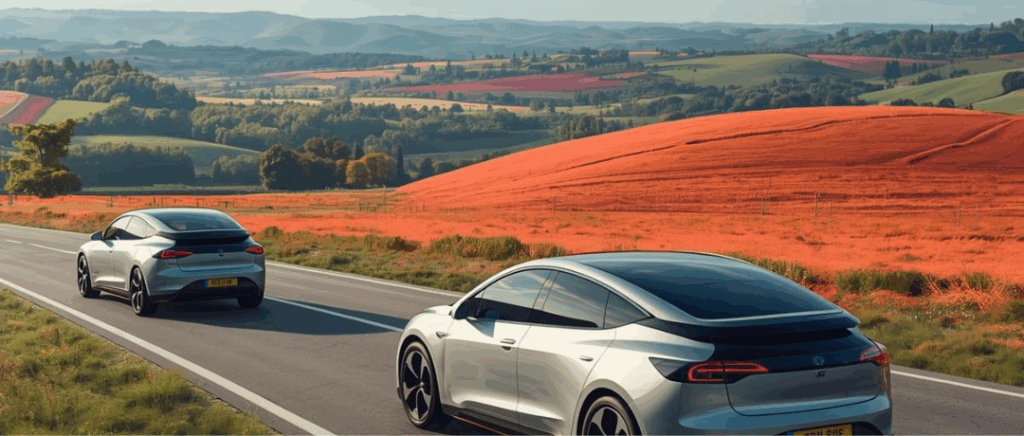Monday to Friday
9am - 12.30pm - 2pm - 7pm
What factors influence the fuel consumption of electric cars?
The impact of the model and technical features
The technical characteristics of an electric car play a crucial role in its energy consumption. Understanding these factors can help consumers to make more informed choices and optimise the use of their vehicle.
The capacity of the battery
Battery capacity, expressed in kilowatt-hours (kWh), is one of the determining factors in energy consumption and energy efficiency.autonomy of an electric vehicle. For example, a battery with a higher capacity generally gives a greater range. However, larger and heavier batteries can increase the overall energy consumption of the vehicle due to their additional weight. For example, the Tesla Model S Plaidwith a high-capacity battery, has an average consumption of 21.1 kWh/100 km.
Aerodynamics
L'aerodynamics of a vehicle also influences its energy consumption. A more streamlined shape reduces air resistance, allowing the vehicle to consume less energy to maintain a steady speed. For example, the Tesla Model 3known for its aerodynamic design, has a relatively low consumption of 14.7 kWh/100 km in mixed driving conditions, contributing to a longer range without increasing the size of the battery.
Motorisation
The type of electric motor used also affects fuel consumption. Modern electric motors, such as those used in Tesla or Hyundai vehicles, are designed to maximise energy efficiency, converting up to 90 % of electrical energy into motion, compared with around 30 % for combustion engines. This efficiency translates into lower energy consumption for a given power output.
Also read → Reducing the energy consumption of an electric car: 8 tips
The importance of eco-driving
Eco-driving is an essential part of optimising the energy consumption of electric cars. By adopting smoother, more considered driving techniques, drivers can not only increase their vehicle's range, but also reduce its environmental impact. It involves a number of practices designed to minimise vehicle consumption:
- Avoiding sudden acceleration and favouring a gradual increase in speed can reduce energy consumption by up to 20 %.
- Anticipate stops by using the regenerative braking instead of the traditional brake, drivers will be able to recover a significant proportion of the energy used.
- Maintain a moderate speed to reduce energy consumption.
What are the benefits?
Studies show that eco-driving can improve the energy efficiency of electric vehicles by 10 to 25 %, depending on driving style and traffic conditions. This translates into extended range and substantial savings on recharging costs. Adopting eco-driving is therefore not only good for the driver's wallet, but also for the planet. By reducing energy consumption, drivers help to reduce overall energy demand and the CO2 emissions associated with electricity generation.
Also read → Eco-driving: what is it and how do you do it?
Measuring real consumption and range
Differences between advertised and actual autonomy
The range of electric cars is the key criterion for prospective buyers. However, it's crucial to understand that actual range can differ significantly from that advertised by manufacturers, due to the testing methods used.
How can we analyse the discrepancy between the figures given and actual performance?
Manufacturers use the WLTP cycle to estimate the range of electric vehicles, as it is considered more representative of real-life driving conditions than the old NEDC (New European Driving Cycle). However, even the WLTP cycle can have discrepancies. For example, one study revealed that the actual range of an electric car on the motorway at full speed can be 50 to 60 % less than the advertised WLTP range.
Examples: The Renault Zoë e-Tech 390 km, it actually offers a range of just 220 km in real-life motorway conditions. For its part, the Tesla Model 3Although presented with a range of 560 km, it achieves just 388 km in real use.
What influence do the test conditions have on the results?
The WLTP cycle incorporates different driving scenarios, including :
- average speed,
- stops,
- speed variation.
However, it is carried out under laboratory conditions which may not perfectly reflect real driving conditions, such as the type of roadthe driving stylethe weather conditions and the loading the vehicle. These factors can all have a negative impact on actual autonomy compared with that tested in the laboratory.
The outside temperature also plays a significant role in the performance of electric vehicle batteries. Low temperatures can reduce the range of an electric car 20 to 40 % due to the reduced efficiency of the battery.
Knowing these differences is essential for drivers and future buyers of electric vehicles, as it enables them to better predict range based on their daily needs and expected driving conditions.
Also read → Electric car battery autonomy: where do we stand?
What are the measurement tools and methods?
To accurately measure the range and fuel consumption of electric vehicles, a number of tools and methods are used, ranging from mobile applications to advanced technological devices. These tools help users to obtain more reliable data on the performance of their electric vehicle in real-life conditions.
| Outil | Fonction principale | Avantages | Exemple d'utilisation | Remarque |
|---|---|---|---|---|
|
Mobile applications
|
Real-time monitoring of energy consumption and location of charging stations
|
Easy to use, provides interactive, real-time updates, often free of charge
|
Users tracking their consumption during a journey, planning long-distance recharges
|
Ideal for regular drivers who want to optimise their recharging stops
|
|
Battery management systems (BMS)
|
Continuous monitoring of battery status and accurate calculation of remaining battery life
|
Direct integration into the vehicle, providing precise data on battery health
|
Drivers analysing their battery's performance to maximise range
|
Essential for the long-term maintenance of the battery and the prevention of damage
|
|
OBD2 scanners
|
Reads vehicle management data via the OBD2 port for in-depth diagnostics
|
Provides technical details on the operation of the vehicle, enabling advanced customisation
|
Vehicle technicians and owners carrying out specific diagnostics or adjustments
|
Requires a certain level of technical knowledge to make full use of the data collected
|
Costs associated with electricity consumption
The cost of recharging at home and at public charging points
Electric vehicles can be recharged at home or at public charging points, with the cost of each depending on a number of factors.
Charging at home is often the most practical and least expensive option. Costs depend mainly on the residential electricity tariff, which varies according to the supplier and the tariff option (peak/off-peak). In France, the average cost of charging an electric car at home with a regulated tariff can vary from €0.1828/kWh in off-peak hours to €0.2460/kWh in peak hours. For a car consuming 15 kWh/100 km, this represents a cost of €2.74 to €3.69 per 100 km travelled.
The costs of public charging points vary more widely because of the different levels of service (slow, fast, ultra-fast charging) and the pricing policies of each operator. For example, a charge at a fast terminal can cost around €0.40 per kWh at Tesla, while other networks can charge by the minute, such as Ionity which offers rates of around €0.59 per minute. These costs can add significantly to the total cost of recharging, especially for fast or ultra-fast sessions.
Also read → How much does it cost to charge an electric car?
Cost comparison with combustion vehicles
Electric cars, although more expensive to buy, can offer significant savings on running costs. Take the example of a typical electric car consuming 15 kWh per 100 km. With an average electricity rate of €0.20/kWh, this equates to a cost of €3.00 per 100 km. By comparison, a petrol car consuming 6 litres per 100 km, with the price of fuel at €1.50/litre, would cost €9.00 for the same distance.
Electric vehicles generally have lower maintenance costs than petrol vehicles. This is due to fewer moving parts and the absence of complex systems such as internal combustion engines and traditional transmissions. Estimates suggest that maintenance costs for electric vehicles can be reduced by 30 to 40% compared with petrol vehicles.
The government offers numerous tax incentives for the purchase of electric vehicles, such as the ecological bonus and the conversion premium. These compensate for the higher initial cost. These incentives also include tax reductions, tax credits and exemptions from certain charges.
Also read → Cost comparison with combustion vehicles
Conclusion
It is therefore important to understand the factors influencing the consumption of electric cars so that they can be adopted more clearly and effectively. From eco-driving to optimise energy use to analysing the cost of recharging, every aspect plays a key role in maximising energy efficiency. In a world that is rapidly transitioning towards more sustainable solutions, becoming familiar with these elements enables consumers to make informed choices that support both the environment and personal economics.
































